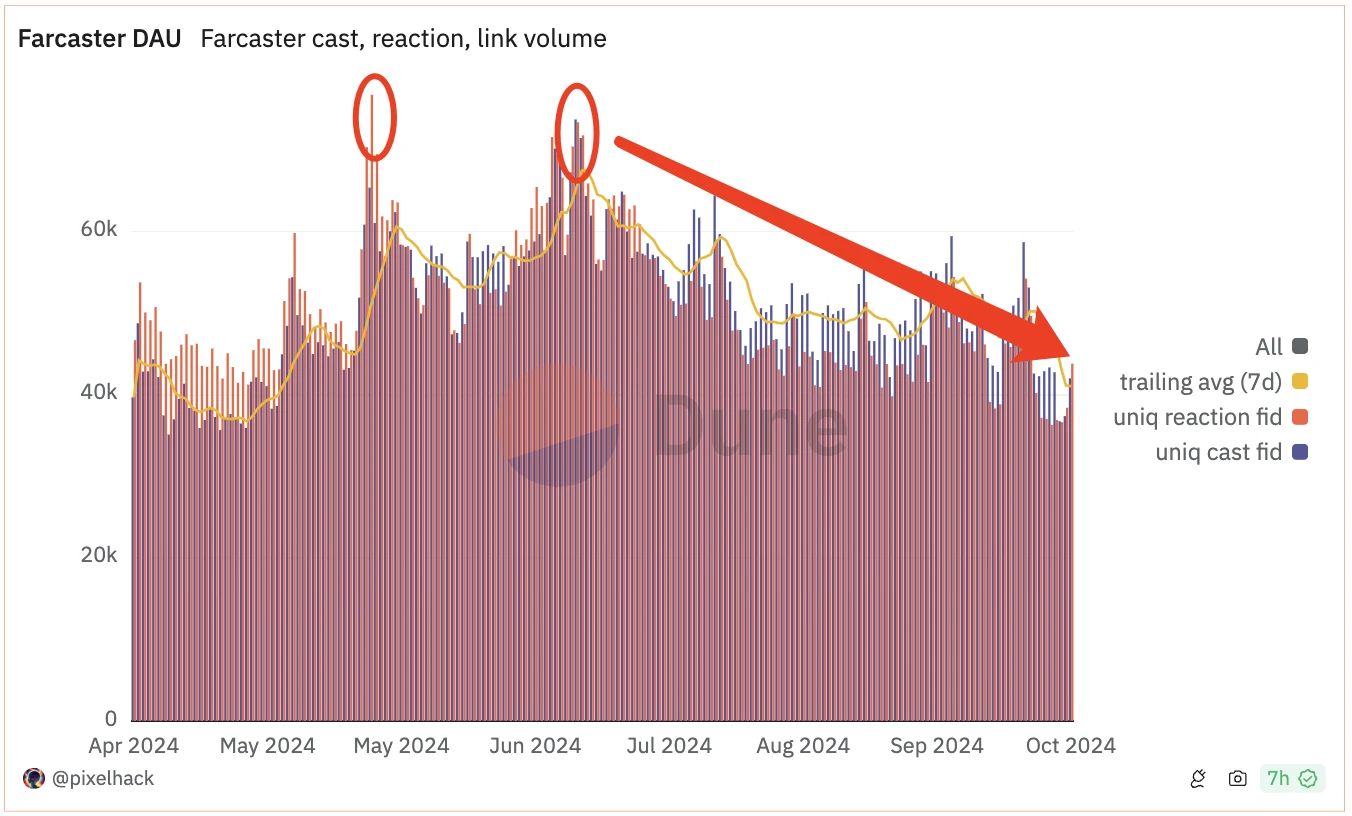SocialFi’s “narrative failure”, does encrypted social networking still have a future?
Original|Odaily Planet Daily ( @OdailyChina )
Author: Wenser ( @wenser2010 )
On October 5, market news said that Web2 social media platform X had paid the fine of the Brazilian Supreme Court and would apply to resume services in the country. This was considered a satisfactory end to the previous conflict between traditional social media and national regulatory forces.
But on the other hand, as the synonym of Web3 social media, the SocialFi track once again ushered in a worrying industry test. The track unicorn Farcaster has been growing sluggishly. Since mid-August , the number of users has increased by only about 30,000, and the protocol revenue has gradually slowed down since July. The current total revenue is only about 2.33 million US dollars. The once hot fried chicken friend.tech chose to give up the control of smart contracts in a nearly soft rug manner after strongly harvesting 81.953 million US dollars in protocol revenue (of which the team received about 45 million US dollars in handling fees).
Although a number of star investors including a16z and Paradigm still choose to bet heavily on the SocialFi track, the development to this point still makes people feel frustrated about the current state of the industry: Is crypto social still a track worth looking forward to? Where is the future of SocialFi? Has the SocialFi narrative failed? What are the problems with social projects in the cryptocurrency industry, and is it a false proposition?
Odaily Planet Daily will discuss this series of articles in stages. This article mainly focuses on the existing problems in the SocialFi track.
SocialFi Problem 1: Going head-to-head with traditional social giants, using their weaknesses to defeat their strengths
The Metcalfe effect states that the utility of a network is often proportional to the square of the number of users.
A number of traditional Internet social media platforms including Facebook, Instagram, Snapchat, WeChat, and Tik Tok and the giant companies behind them have become the traffic origin, attention entrance, and social network carrier of the entire Internet ecosystem based on the accumulated number of users. The track on which these numerous traditional social products are located is exactly the social applications in the field of cryptocurrency, which is the road of bones that SocialFi products choose to use their own weaknesses to attack others strengths.
In ancient times, kings who fought for supremacy understood the principle of building high walls, storing up food, and slowly becoming king. However, when commercial products see the southern walls that are as high as the sky, the choice is not to go around them, but to crash into them head-on – to create products that are no different from traditional social media platforms, and often act under the following banners:
-
“All groups of people are our target users”;
-
“Our goal is to disrupt platform X (Twitter)”;
-
We want to change the current situation in the social field and truly return social data and social power to users.
It has to be said that the arrogance of entrepreneurs in the cryptocurrency industry can be seen from this – they do not consider the real needs of users, nor do they care about the cost of users platform migration, nor do they care whether users care about the so-called decentralized power, nor do they think about the users social network graphs and where the social networks come from and where they go; instead, they unilaterally fall into the trap of self-admiration and self-delusion.
If you know both yourself and your enemy, you will not be in danger in a hundred battles. If you know neither yourself nor your enemy, you will surely perish in every battle.
Farcaster daily active user data
SocialFi Problem 2: No alternative value, and no Trojan horse found
In the 12th century BC, a protracted war broke out between the ancient Greek city-states and Troy. In the end, the city-state coalition forces used a wooden horse hiding many soldiers to sneak into Troy, which mistakenly thought the enemy was retreating, and finally won the war. The Trojan Horse has since become a symbol of a roundabout way to save the country and a false surrender.
The competitors facing SocialFi products are like the long-standing and elusive city of Troy. On the one hand, they need to find their own value to replace or surpass traditional social media platforms; on the other hand, they also need to find the secret to sneak into the enemy camp and break through its fortress from the inside.
Some people pin their hopes on the Fi attribute in SocialFi, that is, using some encrypted social products can get economic rewards, such as token airdrops; while some people regard it as a part of the traditional social media platform (such as paid emoticons, Sofamon in the Base ecosystem, for details, please refer to the author’s previous article Analysis of Sofamon: The next friend.tech or the Web3 version of Centimeter Show? ).
At present, the path chosen by the former will eventually become narrower and narrower in the token airdrop or the spiral decline of token prices, which can be called chronic suicide after the data bubble; the latter is still in the niche demand track and cannot attract attention and introduce liquidity on a larger scale, and it will take some time to verify.
At present, the real Trojan Horse requires an application at the level of AI personalized companion to launch the next round of offensive.
SocialFi Problem 3: Fi for Fi’s sake makes Social a joke
Murphys Law states that if a bad thing can happen, it will definitely happen; similarly, the more people want something, the less likely they are to get it.
For many SocialFi products and SocialFi users, after using Fi for the sake of Fi, Social has become a joke.
Because from a psychological perspective, the essence of social interaction is to find people of the same kind, rather than simply for material incentives such as money. If a person is willing to socialize with others in order to get the incentive of Fi, then his social purpose will naturally become impure, and it will be difficult for him to persist for a long time and engage in more activities with others for the sake of socializing.
When the motivation of wanting to get to know others and explore better interactive relationships with others is distorted into for monetary rewards, then SocialFi becomes a funding scheme in another sense, and the word Social naturally becomes a joke.
If SocialFi cannot provide users with a strong social driving force, the product is destined to be just a financial game in a social shell.
SocialFi Problem 4: Unable to establish a closed value loop, becoming a “capital toy”
All value systems originate from a logical and seamless value loop, which is exactly what the current SocialFi products lack or are even missing.
At present, the value of SocialFi product applications often comes from venture capital from venture capital institutions, and it is impossible to build a relatively clear value closed-loop system. To put it more directly, the current SocialFi product is more like a ranking APP. All the inflow of funds, liquidity and attention is for the purpose of obtaining more economic returns, but it is unable to generate deeper links and connections with other peoples ideas, resources, funds, capital and attention, and thereby stimulate more value exchanges.
In this way, naturally, social value becomes a one-way consumable, and there is no new creation. The users of SocialFi products are not joining an infinite game that is borderless and constantly expanding, but a zero-sum game in which latecomers pay for the early movers.
SocialFi products naturally became a toy for capital to charge high management fees and seek returns on investment – in essence, it is not much different from a PPT full of all kinds of false information and full of pie in the sky .
Since there is no real data and actual value output, it is straightforward to just make a 24/7 casino or data disk.
SocialFi Problem 5: A “Business Model” That Is Not Pure Enough and Is Swaying
The business model of most SocialFi products on the market is still one of the most stable approaches in the cryptocurrency industry – charging transaction fees.
However, the steps and links for collecting fees of SocialFi products are very different from the transaction links carried out for purely speculative purposes in GameFi, NFT and other tracks, and are also different from the staking and interest-earning of DeFi, Restaking and other tracks that seek to reduce the supply of tokens and increase prices. Instead, it needs to rely on intermediary carriers such as social content, social relationships and social influence to promote the establishment of a larger social network.
At a time when industry liquidity is tightening and the number of active participants in the industry is decreasing, this has undoubtedly become an insurmountable hurdle for many SocialFi projects.
Either it can be niche enough to be self-sustaining and take the route of surrounding the cities from the countryside to accumulate small amounts into large ones; or it can be popular enough to attract more people to what you see is what you get and take the route of strangers VS marriage and love, choose one of two to serve the real needs of some people.
Otherwise, SocialFi products will most likely remain stuck in place and will not be able to reach the future when the next wave of encryption arrives.
Summary: Social or commission sharing, that is the question?
Nowadays, many SocialFi products simply and crudely abstract social graph and social products into products that share commissions through social recommendations. It has to be said that this is the most realistic profile of the current data-only industry.
But this is obviously not a normal social phenomenon. Take the phenomenal e-commerce platform like Pinduoduo. Although it has promoted the rapid growth of the e-commerce user network through social relationships, it is mainly a bilateral trading platform serving buyers and sellers. This is its basic foundation.
A true social platform should help people build social relationships with others faster, better, more directly and more harmoniously, rather than treating people as data mines that can be forgotten and no longer cared about after their economic value has been extracted.
This article is sourced from the internet: SocialFi’s “narrative failure”, does encrypted social networking still have a future?
Original author: OurNetwork Original translation: TechFlow The Crypto x AI space is an emerging area within our industry that has profound implications for the wider tech industry. While it is an elusive category that we are just beginning to explore more deeply, the past 18 months have seen the emergence of some exciting projects that leverage AI in a variety of ways, covering areas such as infrastructure, consumer, and decentralized finance (DeFi). Whether it’s decentralizing computation to create a peer-to-peer marketplace that turns machine learning into tradable products or leveraging AI to build the first decentralized self-managed artist, the natural intersection of blockchain technology and AI is bringing about a steady stream of innovation. So, let’s explore some of these emerging projects! 1. Bittensor Jack Forlines Bhavin Vaid | Website…









